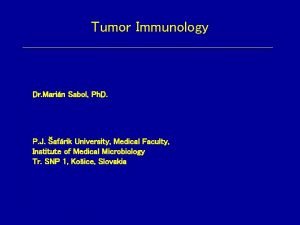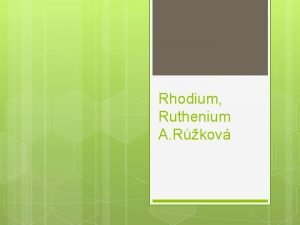The Development of Cytotoxic Ruthenium II Arene Cyclometalates

- Slides: 1

The Development of Cytotoxic Ruthenium (II) Arene Cyclometalates Using Various p. H Dependent Ligands Alyssa J. Bangrazi University of New Hampshire, Department of Chemistry ab 2015@wildcats. unh. edu Introduction Results and Discussion Ruthenium-based metallodrugs have recently emerged as promising therapeutic agents in anticancer therapy. 1 Additionally it has been discovered that these compounds are useful in developing newer anticancer agents whose biological and pharmacological properties can be readily modified by changing the ligand type. This idea was tested experimentally by synthesizing similar compounds that varied by ligand p. H through an adapted procedure from Riedl et al. By changing the ligand as well as the p. H, these compounds can be used to study how well they fight cancer cells, due to the diseased cells having a slightly lower p. H than healthy cells. 2 Based on this knowledge, a ligand with a p. H greater than 7. 5 is more likely to react with tumor tissue than healthy tissue because the tumor tissue is more acidic. 2 Additionally by changing the ligands, and subsequently the ligands p. H, size and charge, the permeability of these compounds can be studied and compared to one other. Conclusions The synthesis of the intermediate, 1 -methylpropane-4 phenyl-1, 2, 3 -triazole (B) was determined to be successful through analysis of 1 H NMR. The synthesis of the final product (C) cannot confidently be determined as successful by analysis of 1 H NMR, however some peaks appeared similar to what was expected. The Cu. AAC reaction to the intermediate, 1 -methylpropane-4 -phenyl-1, 2, 3 -triazole (B) was successful by analysis of ¹H NMR. The substitution reaction to product (C) produced an 1 H NMR that was not clear enough to confidently interpret however produced some peaks similar to what was expected. The 1 H NMR of the aquationanation reaction was inconclusive. The synthesis using the R group acetanilide was also suggested to have been successful through analysis of 1 H NMR. The procedure however should be studied further to find a more efficient reaction. Additionally it was concluded that the synthesis using the R groups acetophenone, and 3 -chlorophenol were unsuccessful by analysis of 1 H NMR. These reactions require future research in order to determine the correct conditions these reactions should be run in. The aquation-anation reaction requires further research for all of these compounds in order to properly conclude their functionality. a. R= methylpropane b. R= acetophenone c. R= acetanilide d. R= 3 -chlorophenol Future Work d a Figure 1: 1 -substituted 4 -phenyl 1, 2, 3 -triazole studied p. H dependent ligands. b f c e featuring Experimental Design Figure 2: 1 H NMR of the intermediate, 1 -methylpropane-4 -phenyl-1, 2, 3 -triazole (B) A multistep synthesis was performed using the starting material 1 -bromo-2 -methylpropane (A), sodium azide, sodium ascorbate and phenylacetylene to yield 63% of the intermediate, 1 -methylpropane-4 -phenyl-1, 2, 3 triazole (B). A substitution reaction was performed using [Ru(ρ-cym)Cl 2]2 and sodium acetate to give 28% product (C). Each product was analyzed with 1 H NMR to verify purity; and the functionality of the final product was tested through the method of aquation-anation. The diffusion of the compounds through semipermeable membranes can be tested through method of dialysis. This could be done to test the permeability of the synthesized compounds—which is a critical feature to ensure the metallodrugs are capable of targeting the tumor cells. Acknowledgements Zane Relethford, Dr. Roy Planalp and the UNH Department of Chemistry References 1. Christoph. A. R. , et. al. Inorganic Chemistry Introducing g b a A B d c e k i f h j 2. Tannock. I. F. , Rotin D. Perspectives in Cancer Research C Scheme 1: The synthesis of 1 -substituted 4 -phenyl 1, 2, 3 triazole featuring the alkyl halide R group, 1 -bromo-2 methylpropane. the 4 -Phenyl-1, 2, 3 -Triazole Moiety as a Versatile Scaffold for the Development of Cytotoxic Ruthenium (II) and Osmium (II) Arene Cyclometalates, 2016 Acid p. H in Tumors and Its Potential for Therapeutic Exploitation, 1989 Figure 3: 1 H NMR of the final product (C)

